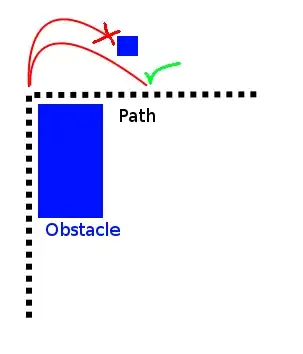Welcome to the wonderful world of non-holonomic motion planning. I recommend doing this using a lattice grid path planner. Other alternatives include the kinodynamic RRT, and trajectory optimization. Non-holonomic systems include cars, boats, unicycles, or really anything where the vehicle can't travel in any direction it wants. Planning for these systems is much harder than holonomic systems and until ~2000 was on the edge of academic research. Nowadays there are lots of algorithms to choose from which work decently.

Here's how it works.
State
Your car's configuration q is actually a 3D state containing the car's x, y position and its orientation t. The nodes in your A* algorithm are actually 3D vectors.
class Node
{
// The position and orientation of the car.
float x, y, theta;
}
Actions
So what about the edges?
That's slightly harder, because your car could actually choose an infinite number of ways to turn the wheel. So, we can make this accessible to a lattice grid planner by restricting the number of actions the car can take to a discrete set, A. For the sake of simplicity lets assume that the car doesn't accelerate but rather can change its velocity instantaneously. In our case, A can be as follows:
class Action
{
// The direction of the steering wheel.
float wheelDirection;
// The speed to go at in m/s.
float speed;
// The time that it takes to complete an action in seconds.
float dt;
}
Now, we can create a discrete set of actions that the car can take at any time. For example, a hard right while pressing the gas at full for 0.5 seconds would look like this:
Action turnRight;
turnRight.speed = 1;
turnRight.wheelDirection = 1;
turnRight.dt = 0.5;
Putting the car into reverse and backing up would look like this:
Action reverse;
reverse.speed = -1;
reverse.wheelDirection = 0;
reverse.dt = 0.5;
And your list of actions would look like this:
List<Action> actions = { turnRight, turnLeft, goStraight, reverse ...}
You also need a way of defining how an action taken at a node results in a new node. This is called the forward dynamics of the system.
// These forward dynamics are for a dubin's car that can change its
// course instantaneously.
Node forwardIntegrate(Node start, Action action)
{
// the speed of the car in theta, x and y.
float thetaDot = action.wheelDirection * TURNING_RADIUS;
// the discrete timestep in seconds that we integrate at.
float timestep = 0.001;
float x = start.x;
float y = start.y;
float theta = start.theta;
// Discrete Euler integration over the length of the action.
for (float t = 0; t < action.dt; t += timestep)
{
theta += timestep * thetaDot;
float xDot = action.speed * cos(theta);
float yDot = action.speed * sin(theta);
x += timestep * xDot;
y += timestep * yDot;
}
return Node(x, y, theta);
}
Discrete Grid Cells
Now, to construct the lattice grid, all we need to do is hash the states of the car into discrete grid cells. This turns them into discrete nodes that can be followed by A*. This is super-important because otherwise A* would have no way of knowing whether two car states are actually the same in order to compare them. By hashing to integer grid cell values, this becomes trivial.
GridCell hashNode(Node node)
{
GridCell cell;
cell.x = round(node.x / X_RESOLUTION);
cell.y = round(node.y / Y_RESOLUTION);
cell.theta = round(node.theta / THETA_RESOLUTION);
return cell;
}
Now, we can do an A* plan where GridCells are the nodes, Actions are the edges between nodes, and the Start and Goal are expressed in terms of GridCells. The Heuristic between two GridCells is the distance in x and y plus the angular distance in theta.
Following the Path
Now that we have a path in terms of GridCells and Actions between them, we can write a path follower for the car. Since the grid cells are discrete, the car would jump inbetween cells. So we will have to smooth out the motion of the car along the path. If your game is using a physics engine, this can be accomplished by writing a steering controller that tries to keep the car as close as possible to the path. Otherwise, you can animate the path using bezier curves or simply by averaging the nearest few points in the path.

